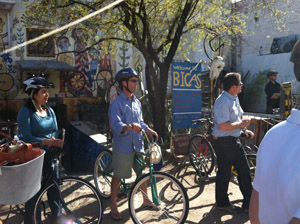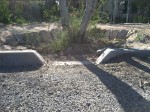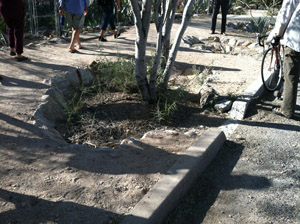The holy book (Rainwater Harvesting For Drylands And Beyond Vol. 1) requires that, at one time during their lives, all Green Infrastructure pilgrims must make their way to Brad Lancaster’s neighborhood in Tucson, Arizona, called Dunbar Spring. Perhaps the most stunning aspect of this oasis of rainwater endowment is the birdsong choir that follows one throughout the visit — birds of all sizes flit from native Mesquite (Prosopis pubescens) to Ironwood (Olneya tesota) and surf the fragile branches of Chuparosa (Justicia californica) and Palo verde (Cercidium microphyllum and Cercidium floridum). Watershed Management Group, hosts of the 2012 Tucson AridLID Conference, arranged for a bicycle tour of Dunbar Spring to get up close and personal with the simple curb cuts and sunken water wells around native trees that identify the neighborhood as the most water-progressive in Tucson.
The bicycle tour started at BICAS (Bicycle Inter-Community Art & Salvage), a collectively-run community-based non-profit education and recycling center for bicycles, devoted to the facilitation of affordable alternatives to travel by auto. BICAS and other people-scale businesses arrived in this neighborhood in the mid-1990’s, around the same time Brad Lancaster was making his first, subversive curb cuts allowing stormwater to flow on to his property from the street. This neighborhood-scale green infrastructure is so very simple — cuts or cores in the curb, native and edible trees and understory plants strategically placed in depressions to receive the flow, meandering decomposed granite pathways, traffic-calming water receptacles in the form of bump-outs and circles, and using paint to create perpendicular parking instead of parallel parking, effectively narrowing the wider of the busy streets. The effect is stunning. Time slows to the pace of a stroller or bicycle. Dappled sunlight filters through wispy, native trees. Colors seem brighter in shaded bird and animal refuge nooks. People smile — laugh — enjoy living in Dunbar Spring.

TV Killed Thinking Man
Now that we have experienced the transformative experience of community-based green infrastructure, we are thinking about how best to transport these lessons to the urban deserts of California. What medium best suits the message of cherished resources and better quality of life? Maybe via cave paintings…



